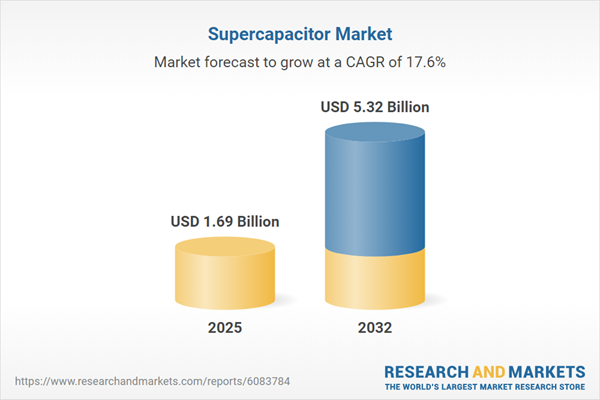Speak directly to the analyst to clarify any post sales queries you may have.
The supercapacitor market is undergoing rapid transformation, driven by industrial electrification, advancements in nanomaterials, and evolving supply chains. Emerging energy storage technologies are increasingly central to modern infrastructure and transport solutions, presenting unique opportunities for stakeholders to achieve operational efficiency and resilience.
Supercapacitor Market Snapshot
The Supercapacitor Market grew from USD 1.45 billion in 2024 to USD 1.69 billion in 2025 and is projected to reach USD 5.32 billion by 2032, expanding at a CAGR of 17.59%. Robust sector development is spurred by demand across consumer electronics, automotive, and grid applications, with innovative electrode architectures and manufacturing advancements moving supercapacitors beyond niche roles. The industry’s trajectory is shaped by an evolving regulatory landscape and a strategic need for fast, reliable energy storage solutions that support electrification and renewable integration worldwide.
Scope & Segmentation
This comprehensive analysis addresses all core dimensions shaping supercapacitor adoption and innovation:
- Type: Electrochemical double-layer, hybrid, and pseudocapacitors (including conducting polymer-based and metal oxide-based).
- Electrode Material: Carbon-based materials (activated carbon, carbon aerogels, carbon nanotubes, graphene), composite materials, conducting polymers (polyaniline, polypyrrole, polythiophene), and metal oxides (manganese oxide, nickel oxide, ruthenium oxide).
- Form Factor: Cell, flexible designs, module, pack, and stack.
- Voltage Range: From below 10V up to and above 50V.
- Application: Aerospace and defense, automotive and transportation, consumer electronics, energy and power, healthcare, industrial, telecommunications.
- Distribution Channel: Offline and online.
- Geographic Regions: Americas (North America and Latin America), Europe, Middle East, Africa, and Asia-Pacific, with in-depth coverage of major countries and emerging markets.
- Company Analysis: Detailed trends and developments across CAP-XX Ltd., Chengdu Holy Tech, Knowles Corp., Eaton Corporation, Ioxus, Jinzhou Kaimei Power, KEMET, LS Materials, Nippon Chemi-Con, Panasonic, Skeleton Technologies, TDK Corporation, UCAP Power, VINATech, and others.
Key Takeaways for Senior Decision-Makers
- Technological advances in nanomaterials and manufacturing techniques are fueling performance gains and market differentiation.
- Supercapacitors are increasingly integral to electrified transport, grid stabilization, and consumer devices, due to their temperature resilience and high cycling capability.
- Strategic partnerships between raw material suppliers and manufacturers are fostering innovation and supporting the emergence of high-performance, locally sourced alternatives.
- Companies are leveraging manufacturing innovations such as roll-to-roll deposition and additive manufacturing to achieve cost efficiency and scalability.
- Accelerating digitalization integrates smart monitoring and predictive analytics into supercapacitor modules, enabling enhanced lifecycle management and system integration.
- The ecosystem is seeing dynamic activity, with mergers and acquisitions, patent races, and alliances strengthening market reach and vertical integration.
Tariff Impact on Global Supply Chains
Recent U.S. tariff measures targeting imported supercapacitor components and raw materials have increased procurement costs for critical inputs, prompting a significant shift in global production footprints. Enterprises are realigning supply strategies, exploring regional manufacturing and sourcing alliances to reduce exposure to duties. This has catalyzed greater collaboration within North America and among international suppliers, driving both innovation in material formulations and advancement of domestic alternatives. These developments are reshaping trade routes and influencing strategic investments throughout the supercapacitor value chain.
Methodology & Data Sources
This report utilizes a rigorous methodology combining primary interviews with industry leaders, technology developers, and supply chain experts, alongside in-depth reviews of industry reports, corporate filings, and authoritative secondary sources. Data triangulation and expert validation were conducted to ensure consistency, accuracy, and actionable insight throughout the analysis.
Why This Report Matters
- Enables informed investment and R&D prioritization in alignment with the latest industry shifts and opportunities.
- Provides targeted segmentation, helping leaders tailor product strategies and partnerships for application-specific success.
- Clarifies regional and policy-driven dynamics that senior executives must navigate to strengthen supply chain resilience and market positioning.
Conclusion
Supercapacitor technologies are advancing into core roles across major industries, driven by innovation, strategic realignment, and new regulatory landscapes. Decision-makers leveraging these insights will be best positioned for sustainable growth and competitive differentiation within this dynamic sector.
Table of Contents
3. Executive Summary
4. Market Overview
7. Cumulative Impact of Artificial Intelligence 2025
List of Figures
Samples

LOADING...
Companies Mentioned
The key companies profiled in this Supercapacitor market report include:- CAP-XX Ltd.
- Chengdu Holy Tech Co., Ltd.
- Cornell Dubilier Electronics, Inc. by Knowles Corp.
- Eaton Corporation PLC
- Ioxus, Inc. by Systemic Power Manufacturing, LLC.
- Jinzhou Kaimei Power Co.Ltd
- JYH HSU(JEC) Electronics Ltd
- KEMET Corporation
- KORCHIP Corporation
- KYOCERA AVX Components Corporation
- LS Materials Co., Ltd.
- Nantong Jianghai capacitor Co., Ltd.
- Nippon Chemi-Con Corporation
- Panasonic Corporation
- PRC Tech LLC
- Shanghai Aowei Technology Development Co., Ltd.
- Shanghai Green Tech Co.,Ltd.
- Skeleton Technologies GmbH
- SPEL Technologies Pvt. Ltd
- TDK Corporation
- UCAP Power, Inc.
- VINATech Co.,Ltd.
- Yunasko Ltd.
Table Information
| Report Attribute | Details |
|---|---|
| No. of Pages | 185 |
| Published | October 2025 |
| Forecast Period | 2025 - 2032 |
| Estimated Market Value ( USD | $ 1.69 Billion |
| Forecasted Market Value ( USD | $ 5.32 Billion |
| Compound Annual Growth Rate | 17.5% |
| Regions Covered | Global |
| No. of Companies Mentioned | 24 |









